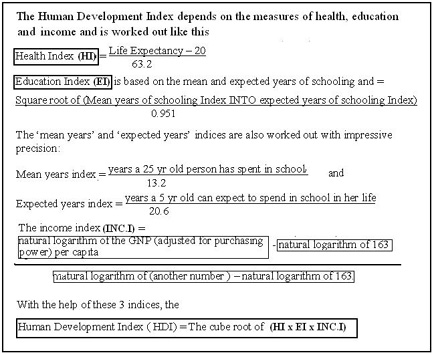Painting the smokestack black
The UN’s index to measure the well being of nations has been shown to be flawed, says S.Ananthanarayanan.
Professor Chuluun Togtokh from Mongolia, in evaluating the level of human development, has worked in the cost to the environment, and finds that when this is done the icons of success in human well being, according to the UN’s existing index for the same
measure, slip many places, to countries with more green and sustainable methods of living. He argues that the present Human Development Index, which is sponsored by the UN, has the effect of idolizing some of the most environmentally rapacious societies. Replacing
the index with one that considers environment friendly technologies would help project ‘greener’ countries and place a value on being responsible in the use of energy. Prof Chuluun Togtokh is a professor of ecosystem and sustainability sciences at the National
University of Mongolia in Ulaanbaatar and vice-chairman of Mongolia’s Global Change National Committee. His findings have been projected by the International Geosphere-Biosphere Programme (IGBP) of the Swedish Academy of Sciences and his article has been
featured in the journal, Nature.

Human Development Index
The HDI is the outcome of a most earnest effort, with origins in a report of the UNDP, "to shift the focus of development economics from national income accounting to people centered policies". Much of the credit for its formulation goes to Pakistani economist
Mahbub ul Haq and India’s Nobel laureate, Amartya Sen. Amartya Sen had opposed the idea of expressing the complexity of the human condition in a single index, but Haq argued that this was necessary, to turn the gaze of planners from economic indicators to
those of human felicity.
The formula worked out considers 3 factors as the indicators of welfare: health, education and prosperity. The indicator for health is the life expectancy at birth, of education the years of schooling and of prosperity, the per capita national income,
normalized against the Dollar by purchasing power. Complex mathematics has gone into arriving at the correct average to be considered and the final formula is formidable and scholarly, as can be seen in the box.

Based on this fine measure, formalized in this very month (November), 20 years ago, The United Nations have graded countries as more and less people friendly and have published the findings, to set up for countries lower in the ranking the examples of
the highest ones to follow and emulate. Apart from the validity of the method of ranking being open to question, there remains the uncertainty of the figures being adopted. But this has been the yardstick and nations the world over have been labeled, as low-human-developed
or backward, and road sign – to go towards higher ranking, has been used by industry, politics and advertising.
Carbon Footprint
With the clearly large incomes of countries like the USA, which have become large energy users, and compulsory school education, and good nutrition that they enjoy, the formula is guaranteed to show these countries as the most oriented to ‘human development’.
Professor Chuluun Togtokh questions the validity, in the present day context, at any rate, of the factors that are being considered. No doubt, the index has the merit of simplicity and apparently measuring what is important to humans. But the result is that
with only these goals taken as criteria, the other practices and means used by countries that score high get left out and the ‘gas guzzling’ developed nations have been ‘celebrated’.
While the world and the UN go to all ends to speak for ‘sustainable development’, the use of the HDI as a measure of development, which holds up the developed countries as ‘advanced’, raises grave questions about the real commitment to sustainability.
The per capita CO2 consumption in the developed countries, is of the order of 15 to 50 tonnes ( in 2008). (France is an exception, but this is because it generates over 85% of its electricity needs from nuclear plants). In comparison, the per capita consumption
(2008) in India was 1.4 tonnes and only a tenth of a tonne in Pakistan and some African countries. With burning of fossil fuels and industrialization rapidly polluting the earth’s resources and environment, the standard of living in the developed world is
clearly at the cost of others and the future of the earth – hardly the way for the rest of the world to go. But the HDI shows the largest offenders as the most people friendly and the world persists in the apparent belief that resources will last forever and
the earth will somehow survive ‘development’.
Prof. Togokh reworked the Human Development Index by taking one more factor into consideration – the per capita carbon footprint. Prof. Togtokh notes that the per capita carbon emissions are ‘a simple, available and quantifiable indicator’, which is seen
to be positively and strongly correlated with income and not at all with health and education. There is a question of what does income really have to do with ‘well being’ – if it is a means to real value, then the indicators of that value should speak and
income may best not be considered. But Prof Togtokh has only taken into account also the negative effect of carbon emissions, to make the formula a little more complete, and he has reworked the index as a Human Sustainable Development Index (HSDI), and found
new gradings.
The effect is that with this adjustment alone, some of the giants of development fall in the ranking – while others, equally affluent and with high living standards, rise in the ranking, thanks to their more green and carbon emission free methods.
Some of the countries are shown in the figure.
We can see that USA, Australia and Canada plummet in ranking, while, Norway, with low carbon emissions, stays high and Sweden, with and an even lower carbon figure, rises to No 2.
This change in the ranking alone is eloquent. It shows up the largest carbon emitters are not the best in the world. On the other hand it shows that countries with high living standards, like Norway and Sweden, can still keep carbon emissions down, by
adopting more responsible technologies. The earth, in fact, is in dire straits and massive reduction in energy consumption is the only answer. Politics and business keep this from happening, but information is also a powerful driver and the published Development
Index has great leverage in influencing individual motives and state policy.
[the writer can be contacted at simplescience@gmail.com]